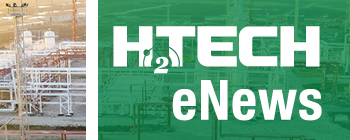News
Online Feature: Mass flowmeters solve H2 value chain application problems
G. FULTZ, Emerson, Boulder, Colorado
While there are some facilities where hydrogen (H2) is produced and consumed entirely within the fence line, most participants in the growing H2 value chain engage in some combination of production, storage, transportation or consumption. Consequently, H2 frequently changes hands as it moves from one stage to the other, perhaps multiple times, along the links of the larger value chain. Even where all these activities take place in one location, it is necessary to measure and quantify flows throughout the process for control and other internal purposes.
Each section of the value chain has its own unique and challenging applications for flow measurement (FIG. 1). In this article, we will examine various key processes throughout the value chain and show how mass flowmeters provide accurate measurements, even for H2, which is a difficult product to measure because it is a very light gas.
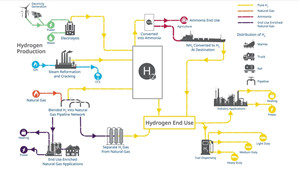
Traditional reforming: Gray and blue H2. Since H2 was first produced for large-scale industrial use more than a century ago, the main process has been reforming natural gas using steam methane reforming (SMR) (FIG. 2). This was the first commercialized process and remains the most common, but it is now supplemented by autothermal reforming (ATR) and partial oxidation (POX) processes. All three processes produce carbon dioxide (CO2) as a byproduct. If the CO2 is released into the atmosphere, the H2 produced is called gray. If the reforming stage is supplemented by carbon capture and storage (CCS), the H2 produced is blue, even though some CO2 from combustion may be released.
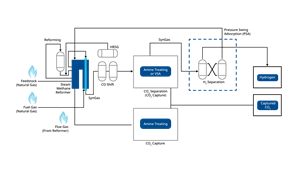
Reforming using any of the processes mentioned is energy intensive as heat is necessary to break down methane molecules. An SMR unit that consumes 10 tons (t) of methane as feedstock to produce H2 will typically consume another 5 t as fuel, primarily to produce steam. Newer processes have improved somewhat in efficiency but are still major fuel consumers. Consequently, for all processes, the cost of H2 produced is inextricably linked to the price of natural gas. Nonetheless, it is still the lowest cost process for producing bulk H2 for large-scale applications.
Reformer units are continuous processes, so effective control is necessary to maintain efficiency H2 quality. This depends on advanced instrumentation to provide an accurate picture of all the variables. There are a series of measurement points in an SMR where flow must be monitored continuously to ensure proper balance across the unit:
- Boiler feedwater
- Boiler steam output
- Export steam
- Natural gas for feedstock
- Natural gas for fuel, both for the boiler and makeup fuel
- Air input
- H2.
These call for various flow metering technologies matched to the specific characteristics of the process media. For example, the first three mentioned above can use a range of options. The other four call for a more specialized approach, particularly where natural gas and other gaseous media are involved.
Coriolis mass flowmeters are ideally suited for gaseous media since they measure mass natively rather than by volume, enabling them to deliver an accurate measurement regardless of temperature or pressure, and even changes of density (FIG. 3). When measuring natural gas, this is especially important as the chemical composition of natural gas is subject to change. While it is mostly methane, it usually includes various components, including ethane, butane, propane and other ballast gases.
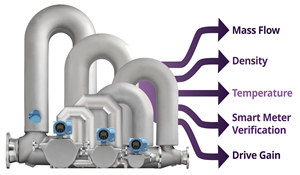
The density of natural gas is a useful indicator of its composition as higher hydrocarbons increase density, as well as energy content. Coriolis mass flowmeters calculate density in real time, so if there is a change in the pipeline supply, it can be recognized immediately, and the process can adjust the steam-to-carbon ratio appropriately to keep it balanced. Moreover, the combustion air supply can also be adjusted to match energy content, thereby optimizing efficiency.
Green H2 via electrolysis. A growing technology for H2 production is electrolysis, where an electric current splits deionized water molecules into H2 and oxygen. This eliminates the need for a hydrocarbon feedstock entirely, and if the electric power is from a renewable source, the H2 produced is designated as green. On an industrial scale, most electrolyzers operate much like a polymer exchange membrane (PEM) fuel cell running in reverse, with a catalyst to increase efficiency. Oxygen and H2 emerge as separate streams for use as desired (FIG. 4).
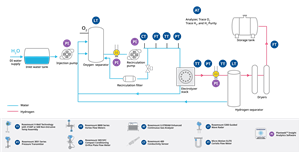
Some electrolyzers have a relatively high-pressure limit for their H2 output and can drive their production into a storage tank at a useful pressure. If the feed must go into a pipeline, or if its pressure is too low for storage, an additional compression stage may be necessary.
H2 storage and transport. While a large proportion of H2 is used in refineries and ammonia production, a wider variety of applications is growing rapidly. These sources and uses tend to be more dispersed, requiring movement of H2 volumes from one place to another, across a city or even over oceans. It is also often necessary to store H2 to balance production and consumption, so new infrastructure is being constructed in many forms to facilitate such distribution.
We can imagine a range of H2 transport requirements across a wide scale of possible volumes and distances:
- Local: From a large warehouse with a roof-mounted photovoltaic system and electrolyzer, to one or more nearby H2 vehicle fueling stations, using a truck that serves both as the collector and deliverer. A small storage tank may be required to smooth out overall flow.
- Intercontinental: From electrolyzer plants in North America, to a green ammonia plant in Europe or Asia. Such a scale calls for an oceangoing tanker carrying liquified H2.
Naturally, there are many options in between depending on the situation (FIG. 5). If the electrolyzers in the second example were supplying a nearby ammonia plant, it would probably be via a dedicated pipeline to maintain continuous flow.
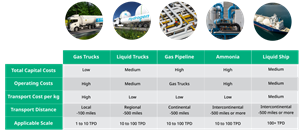
There are various methods for storing H2, either as a liquid or gas, and each poses challenges to conventional piping and vessel designs. For example, H2’s small molecule size means it is prone to leakage, so sealing joints and valves is critical. It causes embrittlement problems with many common metal alloys, shortening the service life of pipelines. Consequently, extra attention must be paid to the materials and instruments used to store and transport H2. Filling and drawing actions from storage tanks must include precise measurements, which can be achieved by utilizing a Coriolis mass flowmeter, whether or not a change in ownership is involved.
The most versatile method of storage in low volumes is via compression between 180 bar and 750 bar, since a wide range of tank sizes are available to handle this pressure range to match any application. These tanks can be mobile or stationary as necessary. Tanks are classified by maximum pressure rating, thereby determining H2 capacity. Tube racks and trailers are normally configured as stacked cylinders with interconnections. Leak mitigation and safety procedures should always be a part of H2 operations, but they are especially important with compressed H2 as high pressures increase the risk of H2 leaks and fires.
Liquifying H2 provides the greatest energy density but presents several challenges to ensure safety. It must be cooled to below −259°C, far lower than propane (−42°C), and even LNG (−162°C). This requires a significant amount of energy, along with exceptionally well-insulated storage vessels. However, once liquified, H2 becomes easier to handle. The equipment necessary to liquify H2 is complex and expensive, making this method better suited for large installations, such as export facilities where tanker ships and trucks are filled.
The easiest and lowest-cost option is to send H2 via pipeline from the source to the user, provided such infrastructure is available. In some cases, the pipeline itself can serve as a storage mechanism, but only if maintaining the necessary pressure is practical.
Flowmeters for custody transfer. Whether filling a tanker truck or sending H2 via pipeline, a custody transfer will likely take place, calling for a high-precision flow measurement (FIG. 6). For large-scale custody transfer applications, international metrology standards call for a maximum allowable shift in accuracy of ±0.167% compared to an international reference standard with disturbed flow conditions present.

A Coriolis mass flowmeter, supported by pressure and temperature measurement, provides all the required data for an accurate picture in compliance with such standards. Many Coriolis flowmeter sizes are available and suitable for this high-pressure service. The meter can be supplemented by a gas chromatograph to evaluate the chemical composition and ensure no ballast gases or contaminants are present.
H2 vehicle refueling. The number of H2-fueled vehicles is growing, creating a need for larger numbers of refueling stations. These are electric vehicles but powered by fuel cells (FCEVs) rather than batteries. While passenger cars are still relatively rare, there are growing numbers of trucks, buses, material handling vehicles and even railroad locomotives that have adopted this technology.
Like any fueling stop, filling an FCEV of any kind with H2 is an exercise in custody transfer. The same concepts apply when buying gasoline or diesel: a flowmeter must provide a totalized volume to calculate the applicable price. Since money changes hands based on the measurement, accuracy is paramount.
The most widely used technology for mass flow measurement is Coriolis, known for its high accuracy and wide turn-down range. It is a preferred method for custody transfer measurements for all hydrocarbons, chemicals and gases. For large line sizes, non-contact measurement and many other types of applications, ultrasonic flowmeters are also widely used.
However, applying ultrasonic or any flowmeter technology to H2 for vehicle fueling is a challenge due to the high pressures involved, as few off-the-shelf models can handle 700 bar (FIG. 7). Accuracy is regulated by standards groups, including the International Organization of Legal Metrology (OIML) standard OIML R 139-1, which regulates compressed gaseous fuel measuring systems for vehicles, as well as the Netherlands Measurement Institute (NMi) certification.
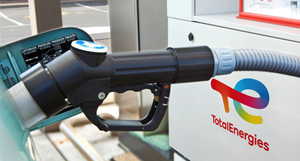
Fortunately, for refueling station service, the line sizes are small since the flowrates do not need to be very high. Typically, 1/8-in. and 1/6-in. (DN2 and DN3) units are sufficient, minimizing the design difficulties for flowmeters in this service.
H2 for natural gas blending. If it is not practical to use surplus H2 for transportation purposes or as a chemical feedstock, it may be advantageous to blend it into the local natural gas distribution system to reduce emissions from combustion. Obviously, this must be done in conjunction with the relevant utility, and it depends on the ability to feed significant volumes of H2 into the pipeline without creating compositional problems. In most areas, the amount of H2 blended into pipeline gas is limited to 20%.
Operating on this scale requires several critical elements:
- The facility must be located in an area where the natural gas distribution system has flow capacity to absorb the amount of H2
- The blending station must be able to measure the pipeline flow and pressure, and capture samples of the incoming natural gas for an analyzer to determine what level of H2 that may already be present from other blending installations upstream.
- The blending station must have compressor capacity to match the pipeline pressure.
- The blending station must have a second analyzer far enough downstream from the injection point to allow for complete mixing to verify that the H2/natural gas blend is within spec.
A blending station in this context must provide a degree of control that the utility will accept as sufficient for protecting the larger system, while keeping the final product in-spec for all consumers of the utility.
Takeaway. As the range of H2 producers and users grows outside of the traditional ammonia and refining sectors, more companies, locations and people will be handling this versatile but complex energy technology. Ensuring these new installations work correctly and safely will depend on partnerships with suppliers able to deliver products, with the know-how necessary to support this foundational energy shift. H2T
NOTES
a Emerson’s Micro Motion™ ELITE™ Coriolis Flow and Density Meters
b Emerson’s Micro Motion HPC015 Coriolis Mass Flowmeter Series
About the author

GENNY FULTZ is a marketing product manager for Emerson, responsible for Micro Motion products. Before joining Emerson, she worked in various marketing and manufacturing roles for process industry companies. Fultz earned BS and MBA degrees from Purdue University.

